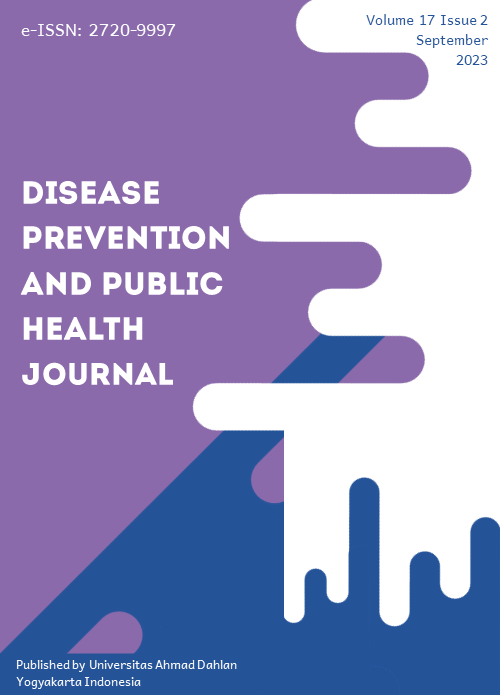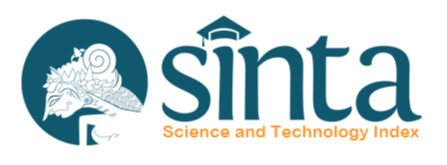University Readiness Analysis Towards Green Campus: A Case Study Using UI GreenMetric
DOI:
https://doi.org/10.12928/dpphj.v17i2.7625Keywords:
Readiness, Analysis, Green Campus, UI GreenMetric, UniversityAbstract
Background: Global warming is a problem that attracts the world's attention because of its harmful effects on living things, including in Indonesia. One of the efforts made by the government is to invite universities to play an active role in reducing the impact of global warming through the green campus program. This study aims to analyze the university's readiness for a Green Campus through a case study at Universitas Respati Yogyakarta (UNRIYO). Method: This research uses a descriptive-quantitative method with case studies at Campus 2 UNRIYO. The population is the entire academic community, infrastructure, transportation, and guidelines that are by the Green Campus indicator. Instruments and data analysis using guidelines from UI GreenMetric with observational variables consisting of 6 indicators, namely Setting & Infrastructure (SI), Energy and Climate Change (EC), Waste (WS), Water (WR), Transportation (TR), and Education & Research (ED). Results: The results of the assessment show that UNRIYO on the SI indicator is at a score of 350 (readiness level 23.3%), EC score of 725 (34.5%), WS score of 450 (25% readiness level), TR score of 0, ED score of 425 (19.4% readiness level). Conclusion: These results indicate that UNRIYO is at a level that is less ready to implement Green Campus. The obstacles experienced are: 1) The supervisory function is still weak so the implementation of the green campus is not sustainable. 2) Incompatibility of infrastructure to realize smart building. 3) There is no sanction and appreciation for the practice of Green Campus. 4) Weak only policy support to create a sustainable environment. 5) Less massive Green Campus socialization, 8) Limited human resources in integrating scientific competence with tri dharma towards Green Campus.
References
Chattu VK. Digital global health diplomacy for climate change and human security in the Anthropocene. Health Promot Perspect. 2022 Dec 10;12(3):277-281. doi: 10.34172/hpp.2022.35. PMID: 36686050; PMCID: PMC9808910.
Abbass K, Qasim MZ, Song H, Murshed M, Mahmood H, Younis I. A review of the global climate change impacts, adaptation, and sustainable mitigation measures. Environ Sci Pollut Res Int. 2022 Jun;29(28):42539-42559. doi: 10.1007/s11356-022-19718-6. Epub 2022 Apr 4. PMID: 35378646; PMCID: PMC8978769.
OCHA. Climate Change Profile: Indonesia. Netherlands. Feb. 2019. Accessed: Oct. 29, 2022. [Online]. Doi: https://doi.org/10.1163/2213-2996_flg_com_098028
Mikulčić H, Baleta J, Wang X, Duić N, Dewil R. Sustainable development in period of climate crisis. J Environ Manage. 2022 Feb 1;303:114271. doi: 10.1016/j.jenvman.2021.114271. Epub 2021 Dec 10. PMID: 34902657.
Ao X, Ong TS, Teh BH. Corporate Sustainability Development Strategy and Corporate Environmental Governance-The Moderating Role of Corporate Environmental Investments. Int J Environ Res Public Health. 2023 Mar 3;20(5):4528. doi: 10.3390/ijerph20054528. PMID: 36901536; PMCID: PMC10001607.
K. Vasiliki and V. Nikolaos. The contribution of higher education to sustainability: the development and assessment of sustainability competencies in a university case study. Education Sciences. vol. 12 no 406, pp. 1-20, June. 2022, doi: 10.3390/educsci12060406.
I. Žalėnienė and P. Pereira. Higher Education For Sustainability: A Global Perspective. Geogr, Sustain., vol. 2, no. 2, pp. 99–106, Jun. 2021, doi: 10.1016/j.geosus.2021.05.001.
W. Stefan and B. Jelena. The emergence of university rankings: a historical sociological account. Higher Education. vol. 5, no. 1–18, 2021, doi: 10.1007/s10734-021-00776-7.
Sostare E, Lawson TN, Saunders LR, Colbourne JK, Weber RJM, Sobanski T, Viant MR. Knowledge-Driven Approaches to Create the MTox700+ Metabolite Panel for Predicting Toxicity. Toxicol Sci. 2022 Mar 28;186(2):208-220. doi: 10.1093/toxsci/kfac007. PMID: 35094093; PMCID: PMC8963288.
Choi KA, Rezaei M. Assessing the Role of Urban Green Areas for Students' Quality of Life during the COVID-19 Pandemic. Iran J Public Health. 2022 May;51(5):1049-1056. doi: 10.18502/ijph.v51i5.9420. PMID: 36407727; PMCID: PMC9643236.
ILRC, UI GreenMetric World University Rankings 2020, vol. 10, no. 1. Integrated Laboratory and Research Center. 2020. doi: https://doi.org/10.5505/itujfa.2022.22566
G. Barbara et al.,. Sustainability university rankings: a comparative analysis of UI green metric and the times higher education world university rankings. International Journal of Sustainability in Higher Education. August. 2021, doi: 10.1108/IJSHE-12-2020-0475.
E. Lourrinx and M. Arief Budihardjo. Implementation of UI GreenMetric at Diponegoro University in order to Environmental Sustainability Efforts. in E3S Web of Conferences. 2019, pp. 1–5, doi: 10.1051/e3sconf/201.
Tait G, Mermer S, Stockton D, Lee J, Avosani S, Abrieux A, Anfora G, Beers E, Biondi A, Burrack H, Cha D, Chiu JC, Choi MY, Cloonan K, Crava CM, Daane KM, Dalton DT, Diepenbrock L, Fanning P, Ganjisaffar F, Gómez MI, Gut L, Grassi A, Hamby K, Hoelmer KA, Ioriatti C, Isaacs R, Klick J, Kraft L, Loeb G, Rossi-Stacconi MV, Nieri R, Pfab F, Puppato S, Rendon D, Renkema J, Rodriguez-Saona C, Rogers M, Sassù F, Schöneberg T, Scott MJ, Seagraves M, Sial A, Van Timmeren S, Wallingford A, Wang X, Yeh DA, Zalom FG, Walton VM. Drosophila suzukii (Diptera: Drosophilidae): A Decade of Research Towards a Sustainable Integrated Pest Management Program. J Econ Entomol. 2021 Oct 13;114(5):1950-1974. doi: 10.1093/jee/toab158. PMID: 34516634.
Liu W, Sun N, Guo J, Zheng Z. Campus Green Spaces, Academic Achievement and Mental Health of College Students. Int J Environ Res Public Health. 2022 Jul 15;19(14):8618. doi: 10.3390/ijerph19148618. PMID: 35886470; PMCID: PMC9317879.
N. Li, P. Jiang, C. Li, and W. Wang. College Teaching Innovation from the Perspective of Sustainable Development: The Construction and Twelve-Year Practice of the 2P3E4R System. Sustain. vol. 14, no. 12, Jun. 2022, doi: 10.3390/su14127130.
Cahyadi A, Hendryadi, Widyastuti S, Mufidah VN, Achmadi. Emergency remote teaching evaluation of the higher education in Indonesia. Heliyon. 2021 Aug 16;7(8):e07788. doi: 10.1016/j.heliyon.2021.e07788. PMID: 34466694; PMCID: PMC8384910.
Dong Y, Zeb S. Role of higher education system in promoting law abiding behavior among students. Front Psychol. 2022 Nov 17;13:1036991. doi: 10.3389/fpsyg.2022.1036991. PMID: 36467184; PMCID: PMC9713821.
G. Sart, Y. Bayar, F. H. Sezgin, and M. Danilina. Impact of Educational Attainment on Renewable Energy Use: Evidence from Emerging Market Economies. Energies. vol. 15, no. 7, pp. 1–15, 2022, doi: 10.3390/en15072695.
W. Jiawen, Y. Minghui, and M. Petra. Sustainable Development at Higher Education in
China: A Comparative Study of Students’ Perception
in Public and Private Universities. Sustainability. vol. 12 no. 2158, pp. 1-19, March. 2020, doi: 10.3390/su12062158
Liu S, Ji Y, Li J, Peng Y, Li Z, Lai W, Feng T. Analysis of students' positive emotions around the green space in the university campus during the COVID-19 pandemic in China. Front Public Health. 2022 Aug 9;10:888295. doi: 10.3389/fpubh.2022.888295. PMID: 36016888; PMCID: PMC9395969.
N. B. Ihda, and H. A. Risqianti. UIN Walisongo Green Campus Study: Implementation of Education Readiness in the Faculty of Science and Technology. Journal of Environmental Education and Sustainable Development, vol. 23, no. 2, pp. 1-14, Dec. 2022, doi: 10.21009/PLPB.232.01.
M. Marsudi et al. The Green Campus Concept using UI GreenMetric for Sports Center Facilities of Universitas Papua Manokwari. Agrikan: Jurnal Agribisnis Perikanan, vol. 14, pp. 1-9, 2020, doi: 10.29239/j.agrikan.14.2.216-231
M. Junainah, B. N. Abu, and S. V. O. Kim. Green campus universities: case studies on problems and prospects. F1000Research. Oct. 2022, Open Peer Review, https://f1000research.com/articles/11-1200. doi: https://doi.org/10.12688/f1000research.73381.1
Faruque MO, Feng G, Khan MNA, Barlow JW, Ankhi UR, Hu S, Kamaruzzaman M, Uddin SB, Hu X. Qualitative and quantitative ethnobotanical study of the Pangkhua community in Bilaichari Upazilla, Rangamati District, Bangladesh. J Ethnobiol Ethnomed. 2019 Feb 5;15(1):8. doi: 10.1186/s13002-019-0287-2. PMID: 30722779; PMCID: PMC6364474.
G. Imas, H. Oot, and M. Mieke. Green Campus as a concept in creating sustainable campuses. International Conference on Humanities, Education, and Social Sciences. vol. 2020, no. 2, p. 82, 2018, doi: 10.18502/kss.v4i14.7853
Li X, Ni G, Dewancker B. Improving the attractiveness and accessibility of campus green space for developing a sustainable university environment. Environ Sci Pollut Res Int. 2019 Nov;26(32):33399-33415. doi: 10.1007/s11356-019-06319-z. Epub 2019 Sep 14. PMID: 31522396.
H. Mohd Isa, D. S. Sedhu, N. S. Lop, K. Rashid, O. Mohd Nor, and M. Iffahd. Strategies, challenges and solutions towards the implementation of green campus in Uitm Perak. Plan. Malaysia, vol. 19, no. 16, pp. 60–71, Jul. 2021, doi: 10.21837/PM.V19I16.952.
Ebert DD, Mortier P, Kaehlke F, Bruffaerts R, Baumeister H, Auerbach RP, Alonso J, Vilagut G, Martínez KI, Lochner C, Cuijpers P, Kuechler AM, Green J, Hasking P, Lapsley C, Sampson NA, Kessler RC; WHO World Mental Health-International College Student Initiative collaborators. Barriers of mental health treatment utilization among first-year college students: First cross-national results from the WHO World Mental Health International College Student Initiative. Int J Methods Psychiatr Res. 2019 Jun;28(2):e1782. doi: 10.1002/mpr.1782. Epub 2019 May 9. Erratum in: Int J Methods Psychiatr Res. 2019 Dec;28(4):e1800. PMID: 31069905; PMCID: PMC6522323.
I. Jaya. Implementation of Green Campus-Based Curriculum Implementation of Green Campus-Based Curriculum Model at Islamic Universities in Indonesia. Din, Ilmu. vol. 20, no. 1, p. 2020, 2020, doi: 10.21093/di.v20i1.2015.
S. K. Singh, M. Del Giudice, R. Chierici, and D. Graziano. Green innovation and environmental performance: The role of green transformational leadership and green human resource management. Technol. Forecast. Soc. Change, vol. 150, Jan. 2020, doi: 10.1016/j.techfore.2019.119762.
Kardoyo et al. Influence of the Green Leadership toward Environmental Policies Support. Journal of Asian Finance Economics and Business, vol. 07, no. 11, pp. 458-467, Nov. 2020, doi: 10.13106/jafeb.2020.vol7.no11.459
Zhang Z, Shi H, Feng T. Why Good Employees Do Bad Things: The Link between Pro-Environmental Behavior and Workplace Deviance. Int J Environ Res Public Health. 2022 Nov 18;19(22):15284. doi: 10.3390/ijerph192215284. PMID: 36430002; PMCID: PMC9690767.
A. Sugiarto, C. W. Lee, and A. D. Huruta. A Systematic Review of the Sustainable Campus Concept. Behavioral Sciences. vol. 12, no. 5. MDPI, May 01, 2022, doi: 10.3390/bs12050130.
Giannaccare G, Breda JB. For a greener future of ophthalmology. Eye (Lond). 2022 Mar;36(3):656-657. doi: 10.1038/s41433-021-01445-w. Epub 2021 Feb 19. PMID: 33608644; PMCID: PMC7894230.
J. González-Ramírez, H. Cheng, and S. Arral. Funding campus sustainability through a green fee—estimating students’ willingness to pay. Sustain. vol. 13, no. 5, pp. 1–15, Mar. 2021, doi: 10.3390/su13052528.
R. Clark, J. Reed, and T. Sunderland. Bridging funding gaps for climate and sustainable development: Pitfalls, progress, and potential of private finance. Land use policy, vol. 71, pp. 335–346, Feb. 2019, doi: 10.1016/j.landusepol.2017.12.013.
I. Gandasari, O. Hotimah, and M. Miyarsah. Green Campus As a Concept in Creating Sustainable Campuses. KnE Soc. Sci., Nov. 2020, doi: 10.18502/kss.v4i14.7853.
Downloads
Published
Issue
Section
License
Copyright (c) 2023 Universitas Ahmad Dahlan

This work is licensed under a Creative Commons Attribution-ShareAlike 4.0 International License.
Authors transfer the copyright and grant the Disease Prevention and Public Health Journal right of first publication with the work simultaneously licensed under a Creative Commons Attribution License (CC BY-SA 4.0) that allows others to share (copy and redistribute the material in any medium or format) and adapt (remix, transform, and build upon the material) the work for any purpose, even commercially with an acknowledgement of the work's authorship and initial publication in Disease Prevention and Public Health Journal. Authors are able to enter into separate, additional contractual arrangements for the non-exclusive distribution of the journal's published version of the work (e.g., post it to an institutional repository or publish it in a book), with an acknowledgement of its initial publication in Disease Prevention and Public Health Journal. Authors are permitted and encouraged to post their work online (e.g., in institutional repositories or on their website) prior to and during the submission process, as it can lead to productive exchanges, as well as earlier and greater citation of published work (See The Effect of Open Access).

This work is licensed under a Creative Commons Attribution-ShareAlike 4.0 International License.







